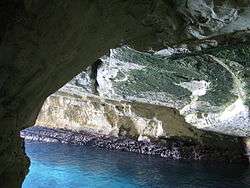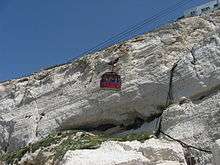Rosh HaNikra grottoes
Coordinates: 33°5′35.24″N 35°6′17.16″E / 33.0931222°N 35.1047667°E

Rosh HaNikra or Hanikra (Hebrew: ראש הנקרה, lit. "Head of the Grottos"; Arabic: رأس الناقورة, Ras an-Nakura) is a geologic formation in Israel, located on the coast of the Mediterranean Sea, in the Western Galilee. It is a white chalk cliff face which opens up into spectacular grottos.
The Rosh HaNikra grottos are cavernous tunnels formed by sea action on the soft chalk rock. The total length is some 200 meters. They branch off in various directions with some interconnecting segments. In the past, the only access to them was from the sea and experienced divers were the only ones capable of visiting. Today a cable car takes visitors down to see the grottos. A kibbutz, also named Rosh HaNikra, is located nearby. The Israeli city Nahariya is located about 10 km (6 miles) south of Rosh HaNikra.
History

The Book of Joshua mentions "Misraphot Mayim" as a place south of Rosh HaNikra that was the border of the Israelite tribes of the time.[1] In the Book of the Maccabees, it is referred to as the place that Shimon HaHashmonai was responsible for in 144BCE (1 Maccabees 11:59). Josephus Flavius also describes Rosh Hanikra as the northern border of the city of Acre, Israel. (The Jewish War 2, 10, 2). The archaeological tell[2] is today situated within the kibbutz.
Jewish sages referred to the cliff as "The Ladder of Tyre" (Hebrew: sullam Tzor).[3] The site was later renamed an-Nawakir ("The Grottos") after an Arab conquest.
Rosh HaNikra has served as a passage point for trade caravans and armies between Lebanon, Syria, Israel, Egypt, and Africa. During World War II, South African forces blasted railway tunnels through the nearby rocks for trains running along the Cairo-Istanbul line. The railway bridge at Rosh HaNikra was spared by the Haganah during the 1946 Night of the Bridges operation but, following a late-1947 British announcement that it would withdraw from Palestine months ahead of schedule, the bridge was destroyed by the 21st Battalion[4] under the Palmach[5] in late February 1948[4] to hinder Lebanese arms shipments to Arab forces opposing the UN Partition Plan. As repairs were prohibitively expensive, the tunnels were later completely sealed. The Lebanese railways have been largely dismantled while the Coastal Railway in Israel currently ends near Nahariya, several kilometers to the south.
Rosh Hanikra was the location where Israeli and Lebanese officials negotiated and concluded an armistice agreement in 1949 which ended the Lebanese-Israeli component of the 1948 War of Israeli Independence. A border passage across the Blue Line into Lebanon at the site is sometimes used by UNIFIL personnel.
Nature reserves and national park
The area around Rosh HaNikra includes a number of nature reserves:[6]
- The Rosh HaNikra islands - 311 dunams declared in 1965
- The Rosh HaNikra reserve - 500 dunams declared in 1969, and an additional 765 dunams in 1996.
- Rosh HaNikra beach - 230 dunams, declared in 2003
The Rosh HaNikra national park also has jurisdiction of 220 dunams in the area.

Cable car

The Rosh HaNikra cable car is a cable car serving tourists wishing to visit the grottoes The Cable car is situated very close to the Lebanese border. The site is popular with tourists, and is one of the facilities available for tourists in Kibbutz Rosh HaNikra. The cable car was manufactured by Austrian manufacturer Doppelmayr Garaventa Group, and claims to be the steepest cable car in the world, ascending at a gradient of 60 degrees.[7] Due to its lower base station being located on the sea, the cable car is occasionally affected by stormy weather.
See also
References
- ↑ Josh. 13:6, also: Josh. 11:8
- ↑ Tadmor, Miriam: article "Rosh Ha-Niqra, Tel", in: Stern, Ephraim: The New Encyclopedia of Archaeological Excavations in the Holy Land, Vol 4, Jerusalem 1993 (English), pp. 1288-1289
- ↑ Rosh HaNikra official website
- 1 2 Milstein et al. (1998), p. 87.
- ↑ Gold (1998), p. 254.
- ↑ "List of National Parks and Nature Reserves" (PDF) (in Hebrew). Israel Nature and Parks Authority. Retrieved 2010-10-05.
- ↑ http://www.gettyimages.co.uk/detail/photo/red-cable-car-in-front-of-white-cliffs-royalty-free-image/136154574
Gallery
External links
- Gold, Stephanie (1998), Israel Guide, Open Road Publishing.
- Milstein, Uri; et al. (1998), Out of Crisis Came Decision, History of the War of Independence, Vol. IV, University Press of America, ISBN 9780761814894.
- Rosh HaNikra site
| Wikimedia Commons has media related to Rosh Hanikra. |
| Wikivoyage has a travel guide for Rosh Haniqra. |





